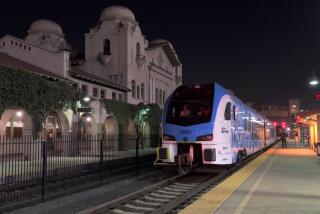Revived CalTrain Would Face Same Money Problems, State Officials Say
A revived CalTrain commuter service in the San Fernando Valley and Ventura County would encounter the same financial and legal problems that forced the cancellation of the line four years ago, transportation officials said Thursday.
Sen. Alan Robbins (D-Van Nuys) introduced a resolution Wednesday urging state transportation officials to determine whether the service can be renewed temporarily to relieve congestion while the Ventura Freeway is being expanded.
Work on the freeway from Universal City to Calabasas is to begin in December and is expected to take four years.
Highway plannners are predicting severe congestion throughout the construction.
Robbins’ resolution suggests that commuters could be accommodated by changing the departure time and adding more stops for a Santa Barbara-to-San Diego train expected to start in October.
The Van Nuys Democrat also proposed adding one additional train to make a round trip each day between downtown Los Angeles and either Simi Valley or Oxnard--in effect re-establishing the CalTrain service.
Even if approved by both houses of the Legislature, a resolution does not have the force of law.
Merely a Directive
The Robbins measure directs, but does not compel, the California Transportation Commission to work with Amtrak and the Department of Transportation in developing the service. The commission oversees rail and highway spending in the state.
The Santa Barbara-to-San Diego train tentatively scheduled to begin in October would be an extension of the San Diegan service that Amtrak operates. It provides six round trips daily between Los Angeles and San Diego.
Unlike the network of light-rail lines proposed for Los Angeles County, which would travel on specially built tracks and obtain power from overhead power lines, the San Diegan trains use existing tracks and cars are pulled by diesel engines.
If the state Department of Transportation and Southern Pacific railroad reach final agreement, said Warren Weber, Caltrans chief of rail services, one San Diegan train will leave Santa Barbara each morning, stopping at Simi Valley, Chatsworth, Van Nuys and Glendale, en route to downtown Los Angeles and San Diego. It would return to Santa Barbara about 10 p.m.
Weber said that while changing the times of departures and returns to accommodate commuters would be “theoretically possible, it would have to be worked out with Southern Pacific, and that could take years.”
He said that if additional trains are added at peak commuting hours, the service would qualify under federal law as a commuter line, rather than an inter-city line such as the San Diegan.
In that case, Southern Pacific “would probably refuse to operate it,” he said, “and by law, they can refuse. They are only obligated to operate inter-city lines.”
Southern Pacific spokesman Jim Loveland said the railroad “would not shut the door on anything, but we would have the same concerns now as we did in the past.”
Weber said the railroad insisted the state make $80 million in improvements in the tracks before it would operate a commuter line.
Loveland said he could not recall the amount, but said it “would be very costly for us to accommodate a busy commuter line on what is a freight line.”
Teri Burns, Robbins’ legislative aide, said the senator introduced the resolution “because the situation is critical with regard to freeway congestion and he feels this could help.”
Transportation officials said another problem a revived CalTrain would face is Gov. George Deukmejian’s policy of withholding state subsidies from inter-city rail lines that fail to obtain 55% of their operating expenses from the fare box and from commuter lines that do not obtain 40% of revenue from fares.
Robert S. Nielsen, executive director of the state Transportion Commission said Wednesday he was aware of no exceptions made to the fare-box rules, although he could recall no short-term service such as that proposed by Robbins.
The fare-box policy was cited as the reason for canceling CalTrain service in March, 1983, shortly after Deukmejian took office.
A pet project of former Gov. Edmund G. Brown Jr., CalTrain was operated for 4 1/2 months on a twice-daily schedule between Oxnard and Los Angeles, stopping at several stations in Ventura County and the Valley.
Ridership averaged 180 round-trip passengers a day, about one-eighth what Caltrans had predicted and only a fraction of the level needed to meet the 40% fare-box standard.
Southern Pacific, which operated the service under protest, blamed the low ridership on lack of demand. However, Caltrans officials blamed the low turnout on the railroad, saying it provided poorly maintained cars and unreliable service.
More to Read
Sign up for Essential California
The most important California stories and recommendations in your inbox every morning.
You may occasionally receive promotional content from the Los Angeles Times.









